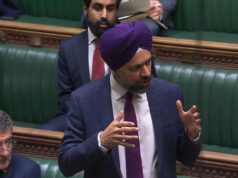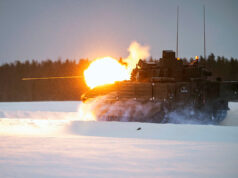Senior Ministry of Defence officials have acknowledged concerns about the UK’s readiness and ability to “sustain the fight,” following recent decisions to retire ageing military equipment.
Speaking before the Defence Committee on 17 December, Lieutenant General Sir Robert Magowan described current operational risks as “manageable” but admitted they remain “uncomfortable” in the short term.
Addressing questions about the scrapping of Typhoon Tranche 1 jets, amphibious assault ships, Puma helicopters, and Watchkeeper drones, Magowan defended the decisions as part of a “ruthless balance of investment” to prioritise future capabilities.
On the Royal Navy vessels recently decommissioned, he stated: “Three of those involved vessels that were no longer seaworthy. We were spending money against capabilities that were never going to be used operationally.” Similarly, the Watchkeeper drones were described as “no longer fit for operational purpose,” with new drone capabilities expected in 2025.
The retirement of Puma helicopters in Cyprus and Brunei sparked further concerns. Magowan explained that interim solutions are being explored to bridge the gap until replacement H-145 platforms enter service in 2026-27. “We’re looking at a range of capabilities right now, this week, providing advice to the Secretary of State on how we might plug those gaps,” he said, expressing confidence that solutions will be found.
Discussing Typhoon Tranche 1 jets, Magowan confirmed they would be replaced by newer Tranche 2 aircraft, particularly for operations in the Falklands. He admitted: “Reducing combat mass is not something we’d want to do necessarily, but we are increasing it through F-35 in the shorter term and GCAP in the longer term.”
However, when pressed about the broader impact on the UK’s deterrence capabilities, Magowan conceded: “We are concerned about our overall readiness. We are concerned about our ability to sustain the fight.” He highlighted key areas where investment is needed, including stockpiles of munitions, medical support, chemical and biological defences, and ensuring modern network infrastructure.
“There are areas where there is operational risk that we’re carrying, which is uncomfortable,” he said, stressing that “pre-emptive investments” are already being made to mitigate those risks.
The session underscored concerns over the MoD’s current readiness amid rising global threats and financial pressures. MPs expressed scepticism about whether savings from retiring older equipment could undermine deterrence in the short term. Magowan, however, remained firm that the Strategic Defence Review will focus on ensuring operational resilience and future capability delivery.
“We are ensuring that we are at the leading edge of future capabilities,” he concluded.














Unless more resources are made available, the SDR can do little more than prioritize some capabilities over others. Given the effective guarantee of funding for nuclear including AUKUS., there would seem to be little resource left to increase conventional equipment beyond plans already announced or underway. Whilst it is good that some acceleration in the T26 build schedule looks possible,,,, this will not be enough to compensate for the worse than expected state of T23s.
So many major programmes will not reach FOC until 2030- Ch3, Boxer, SPG, T31 with at best a small number of F35s added to the fleet. It is hard to imagine what substantive difference this SDR could make.
Good news, more resources are being made available.
Assault ships no longer sea worthy 🙄 what a load of Bull .
Why did he say it knowing it’s not true? If we can’t afford or crew 2 assault ships now, what makes the replacement MRSS a better option, whatever in turns out to be? The fact that this long after MRSS was first mentioned, there seems to be no clarity about its design, raises concern that the Albions won’t be replaced at all. Mentions of large non complex warships that are more fighty doesn’t suggest a cheap vessel. Given the change in the RM role, do large vessels even make sense or would something smaller, capable of company sized operations be more suitable? If so, why was the joint approach with the Netherlands ended?
Andrew, did he say that the assault ships specifically were not seaworthy?
Prioritising future capabilities, when will they arrive?
Never ending excuses when what is needed is honesty that endless high tech can not ever replace the numbers that HMG are so eager to remove.
A balance is needed.
Absolutely agree with Peter S statements. We need to maintain existing resources accelerate current projects under construction eg T26 plus others. Yes the money needs to be found but better to find the cash now than kick the “Tin Can Down the Road” and future generations pay the ultimate price!! We have been here before the ‘Lessons need to be learned”. My major concern is that none of the Political Class of any colour near the Decision making end have either the Leadership Will or Backbone to meet the challenge head on. I pray SDR will be thorough and challenging hopefully Lord Robertson will not be a stooge. Maybe he should check his conclusions through with Ben Wallace prior to release.
The simple answer is it needs to say 3% and no less from 2025 onwards.
I can’t image anyone checking anything with Ben Wallace after the mess he left.
The state of Britain’s defence has very little to do with personalities or even political parties. That is a distraction.
The state of Britain’s defence is a deep cultural problem. Few people want to join the armed forces. Politicians are not interested in thinking seriously about defence. There is a general unwillingness to invest in defence. There is little understanding of military matters at all.
Tempest wont be IOC before 2040+. Why are we not buying new Typhoons to bridge the gap? F35B is not an AD platform. What about all the effort to develop the Mk2 radar for Typhoon. Typhoon is still a very good platform.
what makes you say f35 isn’t an AD platform? If they get Meteor integrated (eventually) it’ll be the best out there by a very wide margin.
Tempest currently set for 2035. Do you have anything showing 2040+?
We need also to stop giving stuff away, learn how to buy off the shelf. And if a “British” firm cannot perform to a strict contract within defined timelines? Fine them. All we hear from politicians is whiney excuses. Nothing changes. And stop buying American kit. Too many conditions attached.
I have no problem with us donating equipment to Ukraine. They’re fighting Russia so that we (and the rest of NATO) don’t have to. I’m happy with giving them whatever they need.
No issue with that, at all.
However, it’s criminal that we’re not rapidly replacing everything that we’re giving to Ukraine, and expanding beyond our original numbers.
You want to buy off the shelf but also British? How do you build the shelf?
I think the problem of “maintain the fight” is somewhat downstream and being used as a political shield to obfuscate the greater issue that right now we’re probably not in the position to “achieve a fight” in a very large areas of what should be core capabilities. Air Defence, Field artillery, Frigates, Tanks etc…
We’re passed the point where we should stop pointing at politicians and calling them clowns. We need some sort of criminal sanction to be held against those who take public office and behave so negligently.
For those with a couple of hours to spare, the procedings are also on YouTube. youtube.com/watch?v=r3an1hhvrGc. First time I’ve heard Andy Start being referred to as the National Armameents Director, although I knew he was in line for the role.
Bring your own bottle.
The only party I can see that pledges a real increase in defence is Reform. I see from their 2024 manifesto they say 2.5% of national income in 3 years and 3% in 6 years, also taking the army back to 100k troops. I’ve been a conservative voter all my life and I have to say over the last 12 years they have failed the country in this respect. Labour also much the same in their period in government previously and I think they’ll shelve any increase this time round to fund other areas. I know where my vote will go next time round.
Yes Reform have made many promises but how do you increase spending and cut tax? Reform very light on details.
I think that a rise in income tax might be necessary to pay for that increase. But if you want increased security as you say it has to be paid for. I guess it depends on individual priorities. Mine are defence and immigration, if this government can throw an extra 30Bn at the NHS without demanding reform up front then why should the Military have to wait a year for a SDR?
Likewise.
They’re trying to block Musk making a donation as well.
A lot of wards/warnings but no contracts, and what little there is will not be ready for 2/5 years. Just bumbling along heads in the sand hoping every thing goes well and no one starts a war till about 2030.
Kicking most things in to the long grass and let it sort its self out. As has ben the way for years. Positive waves can not do much on its own.
So the bottom line from the Top Brass of the MOD is that as a Nation right now, we are FFFF****d!🤔
Onl of we have to do something…..